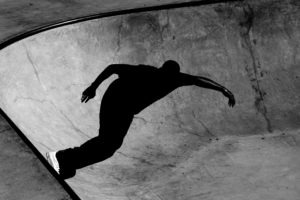If you’re an avid skateboarder, it’s probably difficult for you to imagine a time or place in which skateboarding doesn’t exist. If you’ve ever found yourself wondering about the history of skateboarding, who invented it, and how it came to be, keep reading.
Sidewalk Surfing: The Birth of Skateboarding
According to most sources, skateboarding can be traced back to 1950’s California, which at that time, was dominated by another sport: surfing. As surfers were essentially at the mercy of the waves, the surfing community was in search of something to do when the waves were flat. As an alternative, surfers took wooden planks and attached them to roller skate wheels. Thus, sidewalk surfing was invented.
Who invented the first skateboard?
If you’re searching for a name to credit with the invention of the skateboard, the answer you will get depends on who you ask. While we can’t exactly pinpoint who created the very first iteration of the skateboard, it seems that several people came up with very similar ideas around the same time.
Below, we’re going to dive into two of the most common origins and the lasting contributions of each regarding who invented the skateboard.
Who Invented the Skateboard: Bill Richards
According to some, the first manufactured skateboards can be traced back to a man named Bill Richards. Richards owned a surf shop in Los Angeles, California and took notice of surfers, who during periods of flat waves, would pass the time by rolling around with wheels fitted to their boards. A man of opportunity, Richards realized the potential.
Richards made a deal with the Chicago Roller Skate Company to produce skate wheels that could be attached to wooden boards. The first rudimentary manufactured Roller Derby skateboard hit the shelves. While certainly an innovation in its own right, this early iteration of the board was extremely thick compared to a modern skate deck, and only remotely resembled what we call skateboards today. The only similarity resided in the wheels, which at that time were made of metal.
Who Invented the Skateboard: Larry Stevenson
Some credit the invention of the skateboard to Larry Stevenson, but we can certainly vouch that at the very least, he made the modern skateboard what it is today.
Stevenson, a homegrown Californian, worked as a lifeguard in Southern California in the 1950s. Similarly, to Richards, while on duty, he noticed surfers at Venice Beach rolling around on what were crudely built skateboards. Stevenson took it upon himself to see what he could improve and began getting to work in his garage. He was no stranger to inventing and getting crafty with his hands, as he was already making surfboards in his garage.
Stevenson began by building boards shaped like surfboards, as opposed to Richards’ creation, consisting of a completely level plank. By the year 1963, the demand of his products was so high that he created a company called Makaha, after a famous Hawaiian surfing beach, to mass produce them. The curvature of the end of the board, also known as a kicktail, offered a superior ride to previous iterations, and made today’s skateboarding tricks possible.
Public Reception
At first, reception was warm, likely due to the buzz and excitement surrounding a new sport. In fact, it was Larry Stevenson who played a huge role in promoting skateboarding to the masses, specifically marketing the sport towards youth in areas too far from the ocean.
In 1963, the same year that Stevenson founded Makaha, the first skateboarding competition took place at Pier Avenue in Hermosa, California. The first skateboarding magazine was launched a year later in 1964, founded by the same team of Surfer magazine.
Crash and Burn
In 1966, safety concerns, especially children’s safety concerns, began to dominate the conversation, causing a big drop in sales. Helmets were not commonly worn, and the ones that were widely available tended to be of poor quality. In addition, skate wheels were constructed of baked clay which made skidding very easy. However, in 1972, a surfer named Frank Nasworthy exercised his creative innovation and came up with the idea of polyurethane wheels, which we still use today.
The Rollercoaster of Reemergence and an Extreme Boom
The development of the skateboard wheels we know today allowed for much better grip and paved the way for a new generation of skateboarding. In 1978, Alan “Ollie” Gelfand developed a trick where he jumped with his skateboard. The trick, still named after him today, is the basis of most modern skateboarding tricks. The emergence of competition teams in the 1970s, such as Santa Monica’s Zephyr Competition Team, helped bring more attention to the sport.
Another crash soon followed in the 1980s, and by the early 90s, skating was almost exclusive a street sport. A change in attitude towards authority among youth and the rise in popularity of punk music helped to refuel skateboard’s re-emergence into public consciousness.
The X Games were introduced in 1995, beginning the era of televised skateboarding and other extreme sports. The rest, you could say, is history, with the 2000s and the decades following bringing the most growth to the industry.










